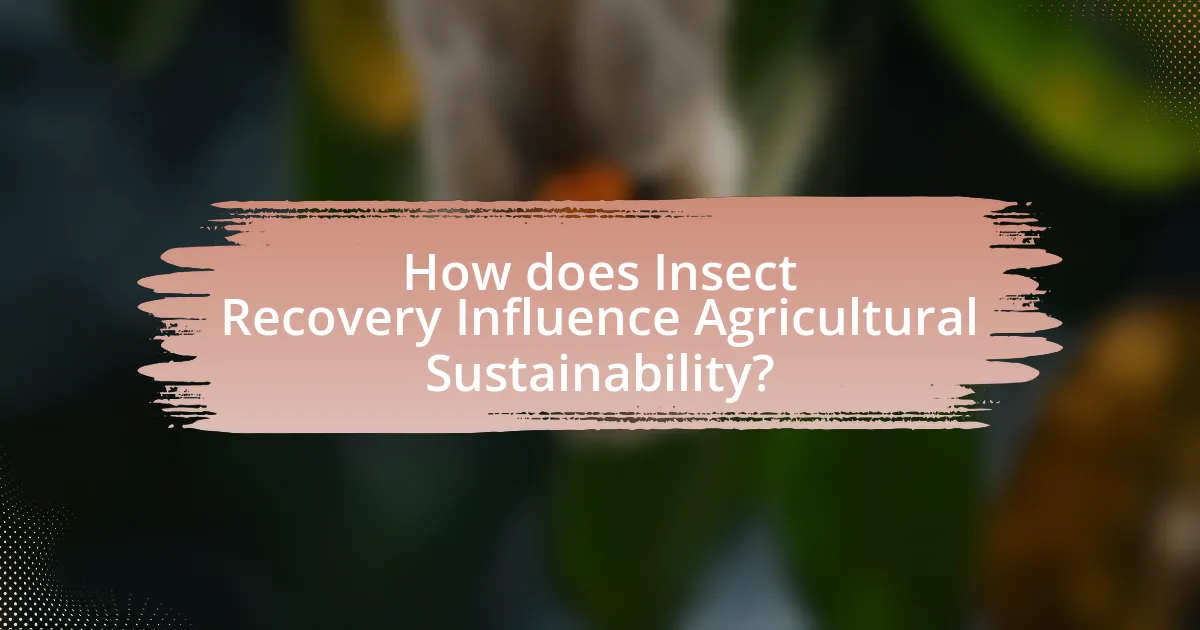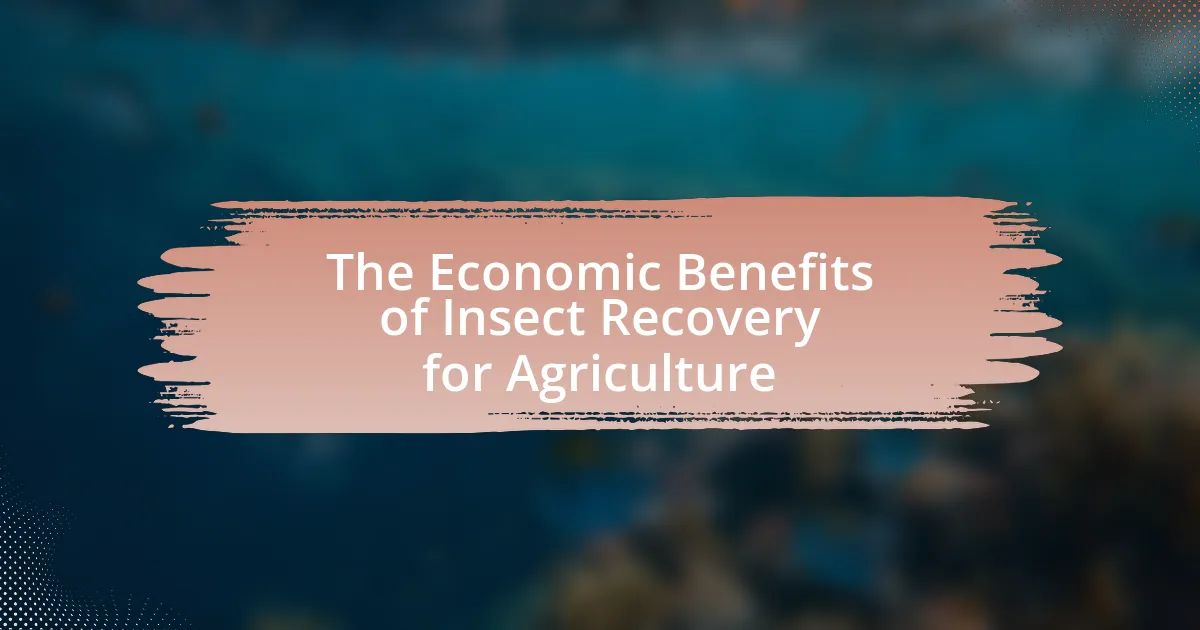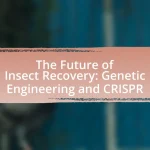The article focuses on the economic benefits of insect recovery for agriculture, highlighting how the restoration of insect populations can enhance crop yields, improve pollination, and reduce reliance on chemical inputs. It discusses the critical roles insects play in agricultural productivity, including their contributions to pollination and soil health, as well as the financial advantages for farmers through reduced pest management costs. The article also addresses the challenges to insect recovery, such as habitat loss and climate change, and outlines strategies that farmers can implement to support beneficial insect populations, ultimately promoting sustainable agricultural practices and enhancing economic viability.

What are the Economic Benefits of Insect Recovery for Agriculture?
Insect recovery for agriculture provides significant economic benefits by enhancing crop yields, improving pollination, and reducing the need for chemical inputs. The presence of beneficial insects, such as pollinators and natural pest controllers, can lead to increased agricultural productivity; for instance, studies show that pollinators contribute to approximately $15 billion in increased crop value in the United States alone. Furthermore, the recovery of insect populations can decrease reliance on pesticides, resulting in cost savings for farmers and promoting sustainable farming practices. This shift not only supports economic viability but also fosters ecosystem health, which is essential for long-term agricultural success.
How does insect recovery contribute to agricultural productivity?
Insect recovery significantly enhances agricultural productivity by restoring essential ecosystem services such as pollination and pest control. Pollinators, including bees and butterflies, are responsible for the fertilization of approximately 75% of the world’s flowering plants, which directly impacts crop yields. For instance, a study published in the journal “Nature” found that improved pollinator populations can increase fruit and seed production by up to 50%. Additionally, insect recovery aids in natural pest management, as predatory insects help control pest populations, reducing the need for chemical pesticides. This not only lowers production costs but also promotes sustainable farming practices, leading to healthier ecosystems and improved crop resilience.
What specific roles do insects play in crop pollination?
Insects play crucial roles in crop pollination by transferring pollen from male to female flower parts, facilitating fertilization and fruit development. Specifically, bees, butterflies, and beetles are among the primary pollinators that enhance crop yields and quality. Research indicates that approximately 75% of flowering plants and about 35% of global food crops depend on animal pollination, with insects being the most significant contributors. For instance, a study published in the journal “Science” by Klein et al. (2007) highlights that insect pollination is essential for the production of fruits, vegetables, and nuts, directly impacting agricultural productivity and economic viability.
How do insects enhance soil health and fertility?
Insects enhance soil health and fertility primarily through their roles in decomposition, nutrient cycling, and soil aeration. Decomposing insects, such as beetles and ants, break down organic matter, which enriches the soil with essential nutrients. For instance, earthworms, which are technically not insects but often included in discussions about soil fauna, improve soil structure and aeration, facilitating root growth and water infiltration. Additionally, insects like dung beetles contribute to nutrient cycling by burying animal waste, which not only recycles nutrients but also reduces soil compaction. Research indicates that the presence of diverse insect populations can lead to increased soil organic matter and improved soil fertility, ultimately benefiting agricultural productivity.
What financial advantages does insect recovery provide to farmers?
Insect recovery provides financial advantages to farmers by reducing costs associated with pest management and enhancing crop yields. By utilizing beneficial insects for pest control, farmers can decrease their reliance on chemical pesticides, which can be expensive and environmentally harmful. Research indicates that integrated pest management strategies, which include insect recovery, can lead to a 20-30% reduction in pest-related crop losses, thereby increasing overall profitability. Additionally, the presence of beneficial insects can improve pollination rates, further boosting crop production and quality, which translates to higher market prices for farmers.
How can reduced pest control costs impact farm profitability?
Reduced pest control costs can significantly enhance farm profitability by lowering overall operational expenses. When farmers spend less on pest management, they can allocate those savings to other critical areas such as crop improvement, technology adoption, or labor, thereby increasing productivity and yield. For instance, a study published in the journal “Agricultural Economics” found that a 10% reduction in pest control costs can lead to a 5% increase in net farm income, demonstrating a direct correlation between cost savings and profitability. This financial flexibility allows farmers to invest in sustainable practices, further enhancing long-term profitability and resilience against market fluctuations.
What are the long-term economic benefits of sustainable insect populations?
Sustainable insect populations provide significant long-term economic benefits by enhancing agricultural productivity and ecosystem services. Healthy insect populations, such as pollinators and natural pest controllers, contribute to increased crop yields, which can lead to higher profits for farmers. For instance, the United Nations Food and Agriculture Organization estimates that pollinators contribute to the production of 75% of the world’s food crops, underscoring their critical role in food security and economic stability. Additionally, sustainable insect populations help reduce the need for chemical pesticides, lowering production costs and minimizing environmental damage. This reduction in chemical use can also lead to improved soil health and biodiversity, further supporting agricultural resilience and sustainability.

How does Insect Recovery Influence Agricultural Sustainability?
Insect recovery significantly enhances agricultural sustainability by improving pollination, pest control, and soil health. Pollinators, such as bees and butterflies, are crucial for the reproduction of many crops; studies indicate that approximately 75% of global food crops depend on animal pollination. Additionally, insect recovery contributes to natural pest management, reducing the need for chemical pesticides, which can harm ecosystems. For instance, beneficial insects like ladybugs and lacewings can decrease pest populations, promoting a healthier agricultural environment. Furthermore, insects play a vital role in soil aeration and nutrient cycling, which are essential for maintaining soil fertility and structure. Research shows that diverse insect populations can lead to increased crop yields and resilience against climate change, thereby supporting long-term agricultural productivity and sustainability.
What is the relationship between insect recovery and biodiversity?
Insect recovery is closely linked to biodiversity, as a diverse ecosystem supports a variety of insect species, which in turn enhances ecosystem functions such as pollination and pest control. Biodiversity provides the necessary habitats and resources that allow insect populations to thrive, leading to improved agricultural productivity. For instance, studies have shown that farms with higher plant diversity can support more insect species, resulting in increased crop yields due to effective pollination and natural pest management. This relationship underscores the importance of maintaining biodiversity to facilitate insect recovery, ultimately benefiting agricultural systems and economies.
How does increased biodiversity affect crop resilience?
Increased biodiversity enhances crop resilience by promoting a variety of species that can withstand pests, diseases, and climate fluctuations. Diverse ecosystems provide natural pest control, improve soil health, and enhance pollination, which collectively contribute to more robust agricultural systems. For instance, studies have shown that farms with higher plant diversity can reduce crop losses by up to 50% due to better pest management and improved ecosystem services. This relationship underscores the importance of biodiversity in maintaining sustainable agricultural practices and ensuring food security.
What role do insects play in maintaining ecosystem balance?
Insects play a crucial role in maintaining ecosystem balance by serving as pollinators, decomposers, and a food source for other organisms. Pollinators, such as bees and butterflies, facilitate the reproduction of flowering plants, which is essential for food production and biodiversity. Decomposers, including beetles and ants, break down organic matter, recycling nutrients back into the soil, which supports plant growth. Furthermore, insects are a vital food source for birds, mammals, and other wildlife, contributing to the food web’s stability. Studies indicate that approximately 75% of global food crops depend on insect pollination, highlighting their importance in agricultural productivity and ecosystem health.
Why is insect recovery important for reducing chemical inputs?
Insect recovery is crucial for reducing chemical inputs because it enhances natural pest control mechanisms, thereby decreasing the reliance on synthetic pesticides. Healthy insect populations, such as predatory insects and pollinators, contribute to ecosystem balance by managing pest populations and facilitating crop pollination. Research indicates that diverse insect communities can reduce pest damage by up to 50%, which directly correlates with lower chemical pesticide usage. This reduction not only minimizes environmental impact but also lowers production costs for farmers, ultimately leading to more sustainable agricultural practices.
How can natural pest control by insects lower pesticide usage?
Natural pest control by insects can lower pesticide usage by providing a biological means of managing pest populations, thereby reducing the reliance on chemical pesticides. Beneficial insects, such as ladybugs and predatory wasps, actively prey on harmful pests, effectively controlling their numbers. Research indicates that fields with higher populations of natural predators can experience up to a 50% reduction in pest-related crop damage, which directly correlates to decreased pesticide application. This ecological approach not only promotes sustainable agriculture but also enhances biodiversity, leading to healthier ecosystems.
What are the economic implications of reduced chemical dependency?
Reduced chemical dependency leads to significant economic benefits, including lower agricultural input costs and enhanced ecosystem services. By minimizing reliance on synthetic pesticides and fertilizers, farmers can reduce their expenditures on these chemicals, which can account for a substantial portion of their operational costs. For instance, a study by the Food and Agriculture Organization (FAO) indicates that organic farming practices, which often involve reduced chemical use, can lower input costs by up to 30%.
Additionally, reduced chemical dependency fosters healthier ecosystems, which can improve crop yields through natural pest control and pollination services provided by insects. Research published in the journal “Ecological Applications” shows that increased insect populations can lead to a 20% increase in crop yields due to improved pollination. This not only boosts farmers’ income but also contributes to long-term agricultural sustainability, ultimately enhancing food security and economic stability in rural communities.

What Challenges and Solutions Exist in Promoting Insect Recovery?
Promoting insect recovery faces challenges such as habitat loss, pesticide use, and climate change. Habitat loss, driven by urbanization and agricultural expansion, reduces the availability of food and nesting sites for insects. Pesticide use further exacerbates the decline by directly harming insect populations and disrupting ecosystems. Climate change alters habitats and food availability, impacting insect life cycles and distributions.
Solutions include implementing habitat restoration projects, promoting organic farming practices, and creating policies that limit pesticide use. Habitat restoration can enhance biodiversity and provide essential resources for insects. Organic farming reduces chemical exposure and fosters healthier ecosystems. Policies that regulate pesticide application can mitigate harmful effects on insect populations.
Research indicates that restoring habitats can lead to a 50% increase in insect populations, demonstrating the effectiveness of these solutions.
What are the main threats to insect populations in agriculture?
The main threats to insect populations in agriculture include pesticide use, habitat loss, climate change, and invasive species. Pesticide use, particularly neonicotinoids, has been linked to declines in pollinator populations, with studies indicating that these chemicals can reduce insect survival and reproductive success. Habitat loss due to urbanization and monoculture farming practices reduces the availability of food and nesting sites for insects, leading to population declines. Climate change alters ecosystems and can disrupt the life cycles of insects, making them more vulnerable to extinction. Invasive species can outcompete native insects for resources, further threatening their populations. These factors collectively contribute to the decline of insect populations, which are crucial for agricultural productivity and ecosystem health.
How do habitat loss and climate change affect insect recovery?
Habitat loss and climate change significantly hinder insect recovery by reducing available resources and altering ecosystems. Habitat loss, primarily due to urbanization and agriculture, leads to decreased food sources and nesting sites for insects, which are crucial for their survival and reproduction. Climate change exacerbates these challenges by shifting temperature and precipitation patterns, disrupting life cycles and migration patterns of insects. For instance, studies have shown that temperature increases can lead to mismatches in the timing of insect emergence and the availability of their food sources, ultimately affecting population recovery rates. Additionally, habitat fragmentation can isolate insect populations, making it difficult for them to recover and adapt to changing environmental conditions.
What impact do agricultural practices have on insect diversity?
Agricultural practices significantly reduce insect diversity. Intensive farming methods, such as monoculture and the use of chemical pesticides, lead to habitat destruction and a decline in food sources for various insect species. Research indicates that landscapes dominated by monocultures can support up to 50% fewer insect species compared to more diverse agricultural systems. Additionally, the application of pesticides has been linked to the decline of pollinator populations, which are crucial for crop production and ecosystem health. Studies show that regions with integrated pest management practices, which promote biodiversity, can sustain higher insect diversity, thereby enhancing ecosystem services essential for agriculture.
What strategies can farmers implement to support insect recovery?
Farmers can implement several strategies to support insect recovery, including adopting integrated pest management (IPM), promoting biodiversity through crop rotation, and reducing pesticide use. Integrated pest management combines biological control, habitat manipulation, and cultural practices to minimize pest damage while preserving beneficial insects. Crop rotation enhances biodiversity by providing varied habitats and food sources, which can attract and sustain insect populations. Additionally, reducing pesticide use mitigates harmful effects on non-target insect species, allowing for natural recovery and population growth. Studies have shown that farms practicing IPM and reduced pesticide applications can see a significant increase in beneficial insect populations, which in turn supports pollination and pest control, ultimately benefiting agricultural productivity and economic returns.
How can crop rotation and polyculture benefit insect populations?
Crop rotation and polyculture can significantly benefit insect populations by enhancing biodiversity and creating a more stable ecosystem. These agricultural practices promote a variety of plant species and growth stages, which provide diverse habitats and food sources for insects. Research indicates that fields with diverse crops support higher insect diversity and abundance compared to monocultures. For instance, a study published in “Ecological Applications” by Kremen et al. (2007) found that farms practicing polyculture had 50% more beneficial insect species than those using single-crop systems. This increase in insect diversity can lead to improved pollination and natural pest control, ultimately benefiting agricultural productivity and sustainability.
What best practices can enhance habitat for beneficial insects?
To enhance habitat for beneficial insects, implement diverse planting strategies that include native flowering plants, which provide essential food sources and shelter. Research indicates that increasing plant diversity can boost insect populations; for example, a study published in the journal “Ecological Applications” found that farms with a variety of flowering plants supported higher numbers of pollinators and pest predators. Additionally, maintaining undisturbed areas, such as hedgerows and wildflower strips, can create safe habitats for these insects, further promoting their presence and effectiveness in agricultural ecosystems.
What practical steps can farmers take to maximize the economic benefits of insect recovery?
Farmers can maximize the economic benefits of insect recovery by implementing integrated pest management (IPM) practices, promoting biodiversity, and utilizing cover crops. IPM reduces reliance on chemical pesticides, which can harm beneficial insects, while enhancing natural pest control mechanisms. Promoting biodiversity through diverse crop rotations and planting native plants increases habitat for beneficial insects, leading to improved pollination and pest control. Additionally, using cover crops can improve soil health and provide habitat for insects, further supporting their recovery. Research indicates that farms employing these strategies can see increased yields and reduced costs, ultimately enhancing profitability.


